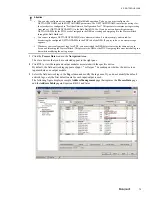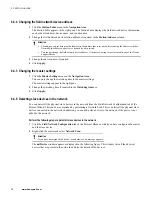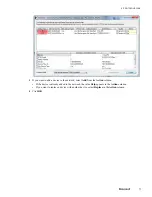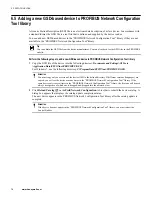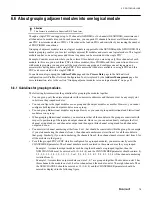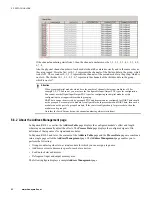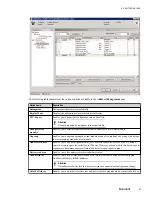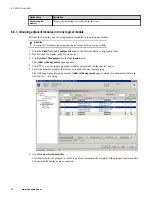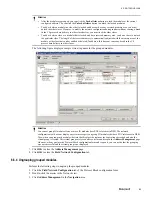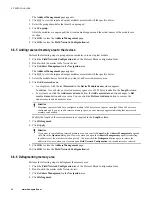
Guidelines for using the Configure In Runtime (CiR) / Hot Configuration in Run (HCiR) feature
The following list summarizes the guidelines that you must follow to use the CIR/HCIR feature.
• Hot Configuration in Run is possible when both the master and the slave devices support this feature.
• Neither Configuration in Run nor Hot Configuration in Run supports the change of parameters or settings
which are global for all slaves. This means parameters like the bus speed, the global watchdog, target token
rotation time and so on cannot be changed using HCiR.
• If the slave device supports HCiR, you must consult the slave device’s vendor documentation to know about
the setup that is required to support HCiR on the slave.
• To use the HCiR feature, you must ensure that all slaves which support HCiR have reserved areas
configured. While configuring the slaves in “Profibus Network Configuration Tool”, it is recommended that
you add reserved input and/or output memory area to the slaves and lock the slaves (Ensure that you lock the
inputs and outputs separately). This helps you to add modules without unlocking the slaves. The length of
the reserved area gets adjusted automatically with the memory area of the module on insertion of a module.
• The Lock/Unlock features are very important for a successful configuration of HCiR. It is recommended that
you lock all your slaves before modifying the configuration to use the HCiR feature. This prevents any re-
arrangement of the “Profibus Network Configuration Tool” address management. Modifying the
configuration includes adding or deleting modules.
• Keep all slaves in the Protocol Block locked all the time. Unlock them when there is no reserved memory
area planned for the device and modification in the configuration is required. After the modification, lock
the slaves.
• By default, the addition of a reserved memory area reserves 128 bytes into the memory map of a slave.
However the length/size of the reserved area can be changed manually based on your requirement.
• If it is likely that complete slaves needs to be added during runtime, these slaves needs to be either planned
as slaves (set to inactive in “Profibus Network Configuration Tool” in order to not be expected during
runtime until they are physically attached to the network), or the Target Token Rotation Time (TTRT) needs
to be tuned upwards already. Both scenarios require a careful planning by a Profibus expert.
• It is a best practice to review and clear all HCiR related settings in “Profibus Network Configuration Tool”
during a plant maintenance shutdown to ensure that all requirements are in place for the next production
phase of the plant and potential HCiR requirements.
• It is recommended that you do not use the Defragment feature. Though this feature does not affect the
locked slaves, it could have an impact if by chance one or more slaves are unlocked when the Defragment
button is clicked.
6 PROTOCOL BLOCK
87
Summary of Contents for Experion PKS
Page 1: ...Experion PKS PROFIBUS Gateway Module User s Guide EPDOC XX88 en 431E June 2018 Release 431 ...
Page 8: ...CONTENTS 8 www honeywell com ...
Page 10: ...1 ABOUT THIS GUIDE 10 www honeywell com ...
Page 32: ...4 PROFIBUS GATEWAY MODULE PGM INSTALLATION 32 www honeywell com ...
Page 58: ...5 PROFIBUS GATEWAY MODULE PGM BLOCK 58 www honeywell com ...
Page 69: ...6 PROTOCOL BLOCK 69 ...
Page 103: ...5 Click OK 6 PROTOCOL BLOCK 103 ...
Page 110: ...6 PROTOCOL BLOCK 110 www honeywell com ...
Page 183: ...PDC Details tab Figure 6 Detail Display of PDC Details tab 7 DEVICE SUPPORT BLOCK DSB 183 ...
Page 186: ...7 DEVICE SUPPORT BLOCK DSB 186 www honeywell com ...
Page 231: ...9 PROFIBUS I O MODULE PIOMB FUNCTION BLOCK 231 ...
Page 232: ...9 PROFIBUS I O MODULE PIOMB FUNCTION BLOCK 232 www honeywell com ...
Page 236: ...10 PROFIBUS GATEWAY MODULE PGM CONFIGURATION EXAMPLE 236 www honeywell com ...
Page 264: ...13 PROFIBUS GATEWAY MODULE PGM TROUBLESHOOTING 264 www honeywell com ...

